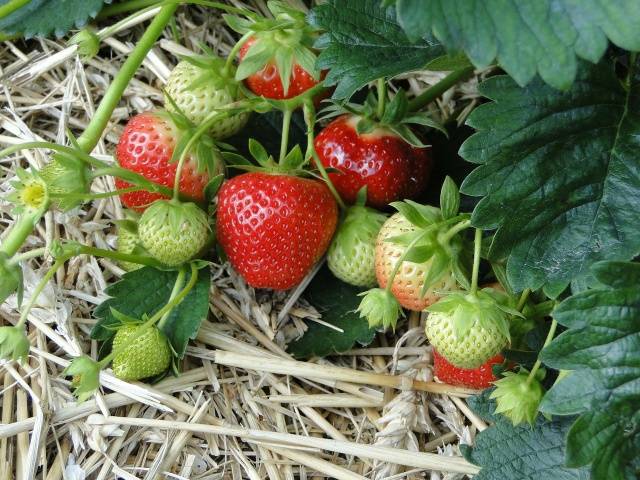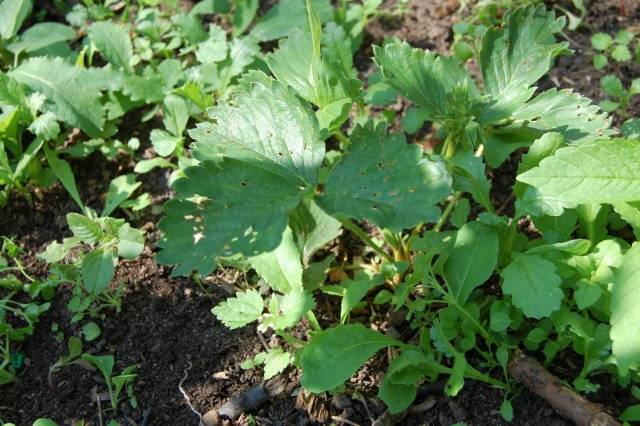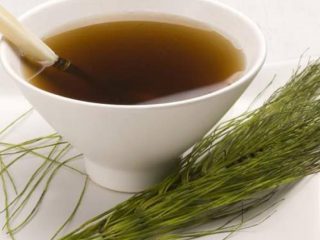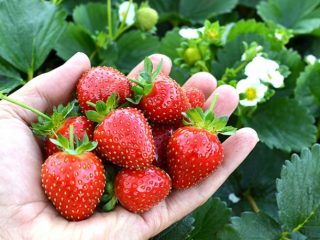Content
Chamora Turusi strawberries are distinguished by their medium-late ripening period, high yield and excellent taste. The origin of the variety is unknown; according to one version, the berry was brought from Japan.
Strawberries have their own characteristics that need to be taken into account when growing. Chamora Turusi is considered an unpretentious variety that can cope with frost.
You can evaluate the external qualities of the variety from the photograph:
Description of the variety
The Chamora Turusi strawberry has the following characteristics:
- ripens in short daylight hours;
- has tall, powerful bushes with a lot of leaves;
- forms many whiskers;
- has high winter hardiness, but does not tolerate drought;
- strawberries are little susceptible to powdery mildew;
- requires additional treatment for fungal infections;
- fruits are comb-shaped, round, rich red;
- the berries have a bright wild strawberry aroma;
- the average weight of Chamora Turusi fruits is from 50 to 70 g;
- maximum fruit weight ranges from 80 to 110 g;
- yield - 1.5 kg per bush;
- Duration of fruiting of strawberries – 6 years;
- the maximum harvest is harvested 3 years after planting;
- the first berries ripen in mid-June, peak fruiting occurs at the end of the month.
Features of cultivation
Caring for Chamora Turusi strawberries includes watering, pruning dried and diseased leaves, and loosening the soil. Particular attention is paid to watering and fertilizing. Strawberries are fertilized several times a season.
Reproduction of the variety
Chamora Turusi reproduces by means of tendrils or by dividing the bush. Plant seedlings quickly take root and grow.
The mustache is not taken from the bushes that have produced a harvest, since the majority of Chamora Turusi's efforts were directed toward ripening the berries. In this case, the plant is not able to produce high-quality seedlings.
To propagate strawberries, select mother bushes, on which all the buds are removed. They leave the strongest tendrils on plants.
The powerful root system of the Chamora Turusi strawberry allows propagation by dividing the bush. For this purpose, plants that give a rich harvest are selected. The procedure is carried out in the spring so that young plantings have time to adapt to new conditions.
The seedlings are first placed in small pots with soil and peat and placed in a greenhouse for several weeks. In the first year, the buds of the Chamora Turusi are removed to help them take root.
Landing rules
The Chamora Turusi variety is planted in chernozem, sandy or loamy soils. Before planting, the soil is fertilized with nutrients.
If the soil is sandy, then the sun will cause the strawberry roots to dry out. As a result, the size and number of fruits decreases. Such soil must be fertilized with peat or compost in an amount of up to 12 kg for each square meter of Chamora Turusi plantings.
In heavy clay soils, the strawberry root system develops slowly. Coarse river sand will help improve soil quality.Often, high beds are set up with a drainage layer of branches.
Leave up to 50 cm between bushes to avoid thickening of plantings. With good ventilation, Chamora Turusi gets sick less and does not attract insects. With this method of planting, it is easy to remove the tendrils, carry out weeding and loosening.
The seedling is placed in the soil to a depth of 15 cm, the roots are straightened and sprinkled with earth. To plant Chamora Turusi, they choose the end of August so that the plant takes root and gains strength. If the region has cold and little snowy winters, then strawberries are planted in May.
Features of watering
The Chamora Turusi variety requires moderate watering. With a lack of moisture, the plant withers, the leaves become hard, and the berries become small. Excessive watering will also not benefit strawberries - the bush will rot, the fruits will taste watery, gray rot and brown spot will spread.
Before watering the plants for the first time, remove the mulch layer and old foliage. The procedure is carried out in the morning to avoid burning the leaves. To water Chamora Turusi, water at a temperature of 15 degrees is required. The water can be pre-heated.
On average, it is enough to water the plantings once a week. In hot weather the procedure is performed more often. The application of fertilizers (mullein, minerals, etc.) is often combined with watering.
Chamora Turusi does not tolerate drought well.Therefore, when temperatures rise in summer, strawberries need to be watered. Access to moisture is especially important during fruiting. Then it is allowed to water daily.
Drip irrigation involves a network of pipes that provide moisture to the roots of plants. As a result, moisture is distributed evenly and its consumption is reduced.
Trimming and loosening
Chamora Turusi strawberries are prone to rapid overgrowth and therefore require constant care. In the spring and after fruiting ends, you need to remove the mustache, old and diseased leaves. Secateurs are used to carry out the work.
In the fall, you can remove all strawberry leaves to direct its forces to the formation of the root system. This procedure has its drawbacks, since the buds from which the berries appear are eliminated. The plant will need more time to grow green mass.
In September, the soil is loosened to a depth of 15 cm between the rows of Chamora Turusi. Under the bush, the loosening depth is up to 3 cm, so as not to damage the rhizome.
Loosening improves oxygen access to the roots, which has a positive effect on the development of strawberries. Loosening requires a fork or a metal rod.
Additionally, the beds are covered with a layer of sawdust, peat or straw. Thus, Chamora Turusi receives protection from pests, and the soil better retains moisture and heat.
Fertilizer application
The use of fertilizers increases the yield of strawberries and promotes their development. To get the largest berries, Chamora Turusi needs to provide comprehensive feeding.Even in the absence of feeding, the plant is capable of producing fruits weighing up to 30 g.
Summer residents feed strawberries in several stages:
- in spring before flowering;
- after the appearance of the ovaries;
- in the summer after harvest;
- during the autumn period.
The first feeding is carried out in the spring after removing old leaves and loosening. During this period, it is necessary to provide the Chamora Turusi strawberry with a supply of nitrogen, which contributes to the growth of green mass of plants.
The solution is prepared using chicken manure (0.2 g) per 10 liters of water. A day later, the product is used for watering.
Ash contains potassium, calcium and phosphorus, which improve the taste of berries and speed up their ripening. When the harvest is harvested, the strawberries are fed with nitrophoska (30 g per bucket of water).
In autumn, mullein is used to feed strawberries. 0.1 kg of fertilizer per bucket of water is enough. The product is infused for 24 hours, then watered at the roots of the strawberries.
Protection from diseases and pests
The Japanese variety Chamora Turusi is susceptible to fungal diseases - brown and white spotting, and damage to the root system. The development of diseases can be determined by the presence of spots on the leaves and the depressed state of the strawberries.
The procedures are performed in the spring before the strawberries begin to bloom. For treatment, fungicides are used that destroy the fungus (Ridomil, Horus, Oxychom).
When they come into contact with plants, they form a protective layer that prevents the disease from developing. Additionally, you can water the soil with an iodine solution (20 drops of iodine per bucket of water).
Chamora Turusi can suffer from chafer larvae, slugs and weevils.Treatment with insecticides (Calypso, Aktara, Decis) will help protect strawberry plantings.
Insect control is carried out before flowering begins. Equipping small ditches into which ash or tobacco dust is poured will help protect strawberries from slugs. Additionally, the plantings are treated with a solution of iodine, ash or garlic.
Reviews from gardeners
Conclusion
Chamora Turusi is valued for its taste, unpretentiousness and large berries. The variety is suitable for growing for sale, canning and freezing. Strawberries require proper care, which includes watering, loosening, pruning, protection from insects and diseases.






















Hello. Tell me where I can buy the Chamora Turusi strawberry variety. We don’t have it anywhere in Khanty-Mansiysk and in general in the Khanty-Mansiysk Autonomous Okrug. I would be grateful if you could tell me the address where I can write it out.
We have had Chamora Turusi for a long time, there is nothing better and there will never be anything better. Contact us in the fall.